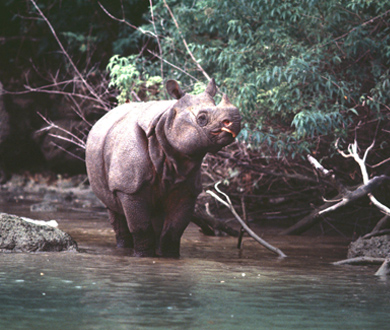Rhino-Tiger Conservation Fund 2011 |
|
| Total Number of Grants Awarded | 53 |
| Total Funds Distributed Through Grants | $2,638,351 |
| Total Partner Contributions Leveraged by Grants | $4,103,892 |
| Total Number of Countries that Received Program Support | 15 |
Rhinos and tigers are big, powerful, and charismatic animals. Unfortunately, these same qualities make these magnificent creatures popular targets: rhinoceros horn and tiger pelts and body parts are in high demand on the global black market.
Once abundant throughout Asia, tigers now live in small fragmented groups and as few as 3,200 remain. African rhino populations fell by 96 percent between 1970 and 1992 and now only about 25,000 remain in the wild. Protection measures in the past decade led to slight increases in rhino populations, but a recent surge in poaching has placed some populations at high risk of extinction. Asian rhinos are particularly threatened: only about 300 Sumatran rhinos survive in the wild, primarily in Indonesia and Malaysia.
The Wildlife Without Borders - Rhinoceros and Tiger Conservation Fund is working to restore rhino and tiger populations to healthy numbers in the wild. Since 1994, the Fund has supported groups engaged in successful conservation efforts. These include fighting poaching; managing habitats and ecosystems; developing nature reserves;developing community conservation initiatives; managing human-wildlife conflict; and raising public awareness.
A 2011 appropriation of $2.7 million, along with more than $4 million in matching funds from host countries and conservation groups, funded 53 rhino and tiger conservation projects in 15 countries across the rhino and tiger range. These included:

Credit: Alain Compost
- South Africa: Supporting operating costs for an aircraft to conduct surveillance patrols in Hluhuwe-iMfolozi Park, where more than 2,000 white rhinos and 200 southern black rhinos live.
- Bangladesh: Assisting people working to prevent tiger-human conflict and strengthening tiger response teams. Each year about 50 people, 60-80 livestock, and three tigers are killed as a result of tiger-human conflict in the Sundarbans region.
- India: Training forest officers in the states of Assam and Rajasthan in prosecuting wildlife crimes, particularly against tigers.
- Indonesia: Expanding habitat for the critically endangered Javan rhino in the Ujung Kulon National Park by clearing space, securing more food and water sources, and supporting trained guards.

